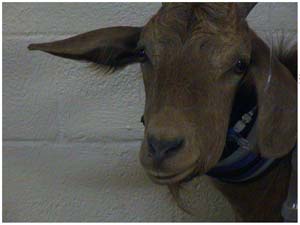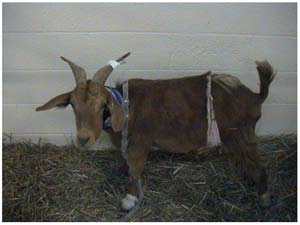Caprine Medical Information
Goat Normal Vitals:
Temperature 101F-104F
Pulse 60 - 90 beats per min.
Respiration 15 - 25 breaths per min.
Estrus/ heat cycle 18 - 21 days
Gestation 142 - 151days
Breeding Season August through January
Adult weight does 50 - 200 lbs.
Bucks 75 - 250 lbs.
* values will vary based on breeds
Basic Care:
Goats can be kept on pasture or in pens. Provisions should be made for exercise and climbing but it is also necessary to ensure that they can't escape or be attacked. Do not put your fence within four feet of any valuable or poisonous shrubbery and make sure it is climb proof. Goats also need a clean dry place to escape the weather. Any one of a number of shelter types can be adequate. Make sure that they are not sleeping or constantly standing on hard or wet surfaces.
Health Concerns
Vaccinations
Most pet and production goats are vaccinated yearly for Clostridium perfringens C and D and Clostridium tetani toxoid. This is currently the only approved vaccine for use in goat in the United States. Recent problems with other clostridial diseases has encouraged more use of the 7-way clostridial vaccine products. consult your veterinarian for recommendations. If does are vaccinated before kids are born and the kids drink adequate colostrum, they should be protected for at least 6 weeks. They should then be vaccinated at 6 to 8 weeks of age and boostered per product label instructions. If the doe was not vaccinated, the kids should be vaccinated within the first few weeks of life and boostered appropriately. All properly vaccinated animals should receive annual boosters. It is best to booster does about 1 month prior to kidding. This will maximize the colostral transfer of immunoglobulins to kids. Other vaccines that may be necessary for certain areas or production herds are rabies, chlamydiosis, multivalent clostridial vaccines, casseous lymphadenitis, leptosporosis, paratuberculosis and contagious ecthyma.
Parasite Control
A fecal analysis and skin/hair examination can reveal most parasites that goat may be harboring. One of the most important common internal parasites of goats is the stomach worm, Haemonchus contortus. Most goat owners routinely deworm and delouse with preparations of ivermectin or panacur. There have been major problems occurring due to misuse of these products. Most clients are underdosing goat by using the cattle recommended dosages. These lower bovine dosages can result in parasite resistance to the drugs by goats. There are many other products being used successfully on goats extralabel fashion. Remember that oral ivermectin is ineffective against ectoparasites. Injectable ivermectin is effective against sucking louse but not chewing louse. Pour on ivermectin maybe effective against both chewing and sucking lice.
Coccidia can become an overwhelming and detrimental problem to animals if neglected. Many products labeled for use to treat coccidia sheep and cattle are also used in goats (i.e. amprolium, albon, monensin, decoquinate, and lasalocid acid). Veterinarians can be a great help to clients in determining what products should be used. There are currently very few anthelmentics labeled for use in goats. Proper sanitation will also help reduce the number of parasites in the herds environment. Many owners with only a few goats or with abundant space, successfully manage parasites with pasture rotation alone.
 Foot Care Foot Care
Goats' feet require routine trimming to promote normal foot structure and limb support. The provision of exercise and rough surfaces can help keep feet from becoming overgrown, but nothing can replace a routine examination and trimming. Depending on the environment, diet, genetics, foot condition, and other factors, it may be necessary to recommend monthly foot trims.
Neutering
Castration of production goats is usually performed when the kids are under one month of age. These are routinely performed by either banding or scrotal ablation and testicular extraction. Pet goat should not be castrated until he is at least 4-6 months of age to prevent potential urinary obstruction problems. These animals should be sedated before performing the proce
Dehorning/Disbudding
The decision to dehorn an animal or not should be based on a number of considerations. In most instances horns are removed to decrease injuries due to fighting in herds. In addition, large goats with horns can be a danger to people and other domestic animals. Removing the horns in these situations may be beneficial. On the other hand, there are situations where an owner may not want to remove the horns such as if other goats in the herd will not be dehorned, if the goat is exposed to predators or if the health of the animal is questionable.
Once a decision has been made to remove the horns of a goat, timing should be considered. Disbudding is the procedure of removal of horns from a young kid, usually at less than 1 week of age. The procedure is relatively noninvasive and the associated pain is relatively short-lived when properly performed. If a goat is not dehorned until later in life when the horns have had a chance to grow out, the procedure is referred to as dehorning and it is quite invasive and there are more possible complications.
Disbudding involves the destruction of the corium, or tissue, surrounding the base of the horn from which it grows (epikeras). The most common method, and the one performed at NC State College of Veterinary Medicine, involves the use of heat cautery to sear the corium in a ring around the base of each developing horn bud. Sedation may be involved and the kid will receive a nerve block to deaden the sensation of the cautery prior to the procedure. Once cauterized, the bud maybe cut off flush with the skull using a scalpel blade and any bleeding cauterized. The site can then be sprayed with an antimicrobial product and topical insect repellant is needed. No further care is normally needed as the scars heal.
Dehorning is an all-together different procedure. The horn is blocked to remove all sensation, and sedation is used as in disbudding. However, a gigli wire is used to remove the horns. A cut is made at the base of each horn, starting on the caudal (or back) side and moving forward flush with the contour of the scalp. The removal of the horns in this fashion can be relatively bloodless, since the friction of the wire cauterizes as it cuts. The main complication of this procedure is the hole left where each horn is removed. Remember that the frontal sinus grows up into each horn as the goat matures and may not be within the horn area at the time that a kid is disbudded. Normally, these holes are covered over by skin with 6-8 weeks but sinusitis and infection with failure of the body to fully cover the holes are two possible complications. These holes should be covered over and maintained with a clean dressing as healing progresses. Cosmetic dehorning is a possible alternative. 
Production goat herd owners should be given proper instruction on how to perform disbudding. For hobbyists it is usually easiest to have a veterinarian perform the disbudding. If necessary, descenting can also be done at this time.
|

